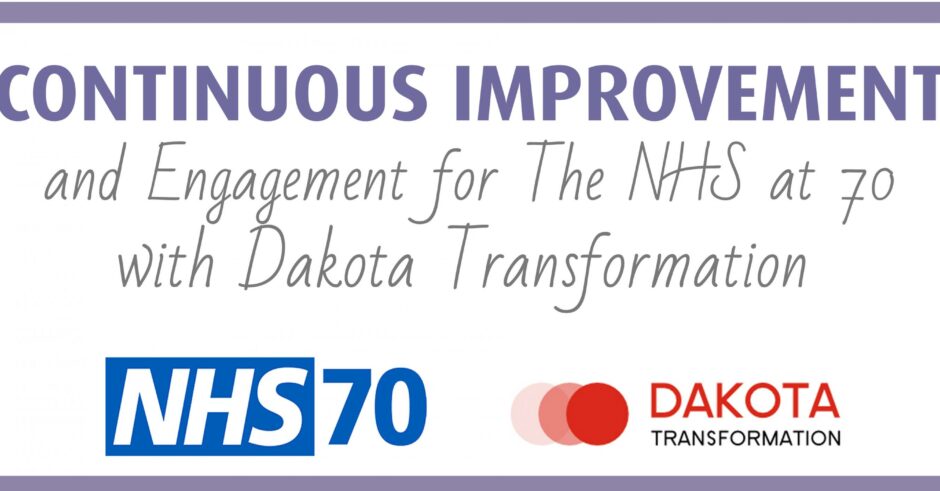Recently I was asked to speak at a leadership event for representatives from all over NHS Scotland, to share some examples of what we had experienced as the critical success factors for delivering improvements in organisations, to ensure lasting results.
Upon reflection, it certainly felt that the 10 factors to deliver sustainable improvements, had a lot of resonance with the challenges and the opportunities the NHS faces at 70.
There are numerous elements that need to be considered to achieve strong engagement in any improvement strategies, be that for the overall aim to establish a culture of Continuous Improvement or at a project level. Without strong levels of engagement, improvement initiatives can certainly fail, no matter how good the improvement idea was in the first place.
For the discussion, we shared 10 critical success factors, that had made a very real difference in the transformations we had been involved in, across multiple industries. Here we would like to share four of those key elements:
Purpose: as Simon Sinek sets out in my favourite TED Talk, on How great leaders inspire action, the ‘Importance of Why’ is critical to the success of business strategy. Most organisation focus on what they need to do and how they will deliver on those objectives. However, without a compelling Purpose, they will lose the opportunity to engage their staff and indeed their customers in the compelling Purpose of that organisation.
This is an incredibly important lesson and also applies at a project, programme and overall business strategy level. If you cannot clearly articulate a compelling purpose for the improvements you are trying to make, you will have real challenges in engaging stakeholders and staff to go on that improvement journey with you. It is worth spending time visualizing with your team, just what success will look like when you have delivered on your improvement initiatives; what will be different, what will it be like to work around here as a result of the changes you are about to do? If that is something worth putting the effort into and, in turn, it aligns to the overall purpose of the organisation then you have a great chance of success.

Communicating the Change: one of the challenges improvement projects face is that the improvement team, often involving senior executives, work in isolation on the improvement strategy. Once they have the “answer” on how to go forward, they chose to announce it at, for example, a large all staff conference. There are a few issues here with this approach – whilst the design team have gone through their very own change curve and are at the engaged and motivated stages – they are communicating to an audience who may well react by resisting that change from a point of view of Denial, Disbelief and Disengagement. Worse still, if the communication does not take into account the engagement style of the different members of the audience it could create more resistance than engagement.
One of the approaches that has been used for effective engagement is that of Insight Discovery, which helps people to understand their style, their strengths and the value they bring to the team. Insights call these colour energies and it’s the unique mix which helps people to understand their and others personal types, and how best to communicate messages of change.
At a very high, general level, here are some of the things you would need to consider for each of the colour energies in your target audience.

So, for those looking to run new improvement programmes, you need to consider how best to communicate the purpose of your initiatives in a way that engages each element of your audience, in turn, becoming curious where any resistance comes from – again that will depend on the colour energy depicted via the Insights Discovery Personal Profiles
However, by working with those different energies and insights, your ability to engage stakeholders in change will greatly increase and give you longer lasting results.
Need for Change: being clear on the need for change, some often call this the “burning platform”, though to be honest I don’t like that approach. Another approach is to reframe the current situation to be able to identify the need for change and improvement. The example we shared was in an insurance organisation, where we asked the question, “when someone crashes their car, when do they get their cash back if it is written off?”. Because the business operated in functional silos, it did not know the answer as no one actually had the complete end-to-end view of the customer experience. However, by asking the question we found out that Crash to Cash was actually 43 days and clearly there was a need for improvement. Through process optimisation, this was reduced to 14 days.
The relevance for the NHS, maybe to ask what are the lengths of the different Patient Pathways, where are the opportunities for improvement and how could that overall time be reduced to the benefit of the Patients and to the benefit of the staff? It was an interesting discussion, as there was a degree of pushback here in the form of “we don’t operate as a process in the NHS”, but for others, the view was “this is where the very real opportunities for improvement will come from”.

Leadership Role Modelling: so you have established the purpose of your improvement strategy, it’s been communicated effectively, and the need for change is fully understood. That can all go by the wayside if the leaders in the business fail to re-enforce the new ways of working that you are trying to establish. After all, people believe what they see and experience, not what they hear you tell them is going to happen. There are a number of things to consider here. One of which, is who should be leading the improvement activities in the business? Should it be the specialist improvement experts or the operational leaders? For what it’s worth, my view is that the people who will live with the change should lead the change, whilst being supported by the improvement experts. It was interesting to hear that NHS Tayside were in the process of establishing a transformation strategy that was going to be led by Clinicians. I have high hopes for the engagement strategy there and in how the end results will be achieved.
To achieve a culture of continuous improvement, these critical elements that will engage stakeholders, staff, and customers in your strategy are critical at the overall cultural transformation level. They’re integral to bringing continuous improvement to life in every single opportunity, and in how you deliver improvement projects.
Within the NHS there are so many fantastic people dedicated to patient care, with so many opportunities for improvement. Therefore, we know the NHS will continue to flourish for another 70 years and well beyond that.
Bryan Robertson, Dakota Transformation
If you missed it, you can view Part 1 on Creating a culture of Continuous Improvement by Bryan Robertson.
The Business Transformation Network has posted this article in partnership with Dakota Transformation.
See the full PDF here.



